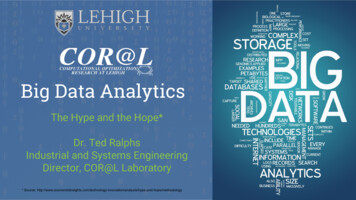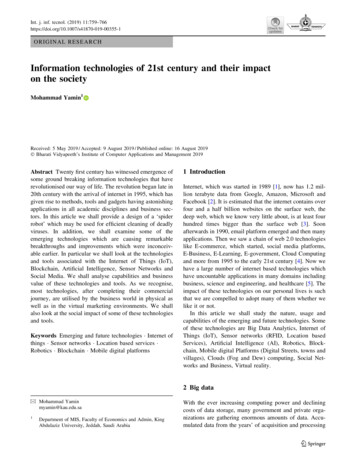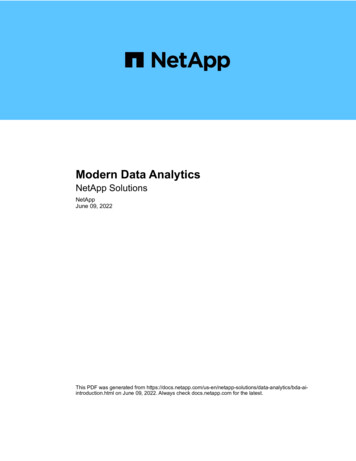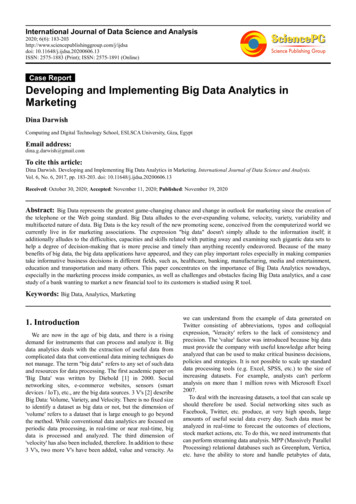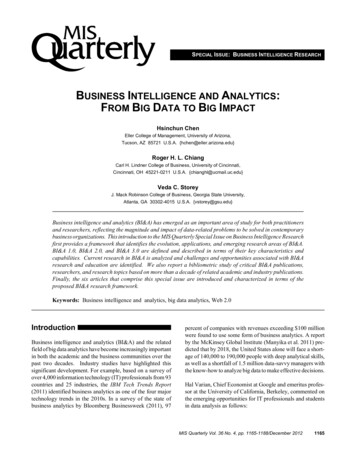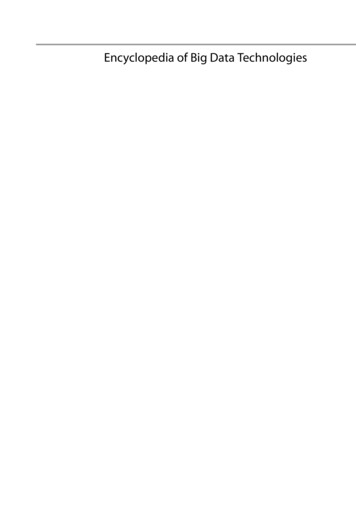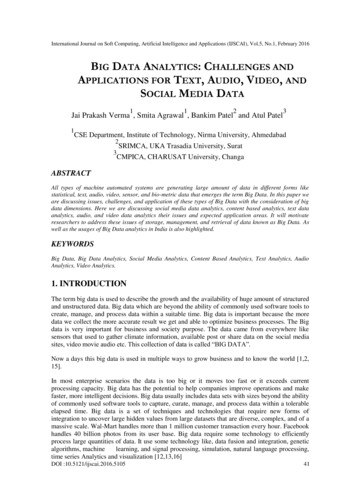
Transcription
International Journal on Soft Computing, Artificial Intelligence and Applications (IJSCAI), Vol.5, No.1, February 2016BIG DATA ANALYTICS: CHALLENGES ANDAPPLICATIONS FOR TEXT, AUDIO, VIDEO, ANDSOCIAL MEDIA DATA112Jai Prakash Verma , Smita Agrawal , Bankim Patel and Atul Patel31CSE Department, Institute of Technology, Nirma University, Ahmedabad2SRIMCA, UKA Trasadia University, Surat3CMPICA, CHARUSAT University, ChangaABSTRACTAll types of machine automated systems are generating large amount of data in different forms likestatistical, text, audio, video, sensor, and bio-metric data that emerges the term Big Data. In this paper weare discussing issues, challenges, and application of these types of Big Data with the consideration of bigdata dimensions. Here we are discussing social media data analytics, content based analytics, text dataanalytics, audio, and video data analytics their issues and expected application areas. It will motivateresearchers to address these issues of storage, management, and retrieval of data known as Big Data. Aswell as the usages of Big Data analytics in India is also highlighted.KEYWORDSBig Data, Big Data Analytics, Social Media Analytics, Content Based Analytics, Text Analytics, AudioAnalytics, Video Analytics.1. INTRODUCTIONThe term big data is used to describe the growth and the availability of huge amount of structuredand unstructured data. Big data which are beyond the ability of commonly used software tools tocreate, manage, and process data within a suitable time. Big data is important because the moredata we collect the more accurate result we get and able to optimize business processes. The Bigdata is very important for business and society purpose. The data came from everywhere likesensors that used to gather climate information, available post or share data on the social mediasites, video movie audio etc. This collection of data is called ―BIG DATA‖.Now a days this big data is used in multiple ways to grow business and to know the world [1,2,15].In most enterprise scenarios the data is too big or it moves too fast or it exceeds currentprocessing capacity. Big data has the potential to help companies improve operations and makefaster, more intelligent decisions. Big data usually includes data sets with sizes beyond the abilityof commonly used software tools to capture, curate, manage, and process data within a tolerableelapsed time. Big data is a set of techniques and technologies that require new forms ofintegration to uncover large hidden values from large datasets that are diverse, complex, and of amassive scale. Wal-Mart handles more than 1 million customer transaction every hour. Facebookhandles 40 billion photos from its user base. Big data require some technology to efficientlyprocess large quantities of data. It use some technology like, data fusion and integration, geneticalgorithms, machinelearning, and signal processing, simulation, natural language processing,time series Analytics and visualization [12,13,16]DOI :10.5121/ijscai.2016.510541
International Journal on Soft Computing, Artificial Intelligence and Applications (IJSCAI), Vol.5, No.1, February 20161.1. Characteristics of Big Data:Volume: Many factors contribute to the increase in data volume. Transaction-based data storedthrough the years. Unstructured data streaming in from social media. Increasing amounts ofsensor and machine-to-machine data being collected. In the past, excessive data volume was astorage issue. But with decreasing storage costs, other issues emerge, including how to determinerelevance within large data volumes and how to use analytics to create value from relevant data[10, 12,13, 15,16].Velocity: Data is streaming in at unprecedented speed and must be dealt with in a timely manner.RFID tags, sensors and smart metering are driving the need to deal with torrents of data in nearreal time. Reacting quickly enough to deal with data generation speed is a challenge for mostorganizations.Variety: Data today comes in all types of formats. Structured, numeric data in traditionaldatabases. Information created from line-of-business applications. Unstructured text documents,email, video, audio, stock ticker data and financial transactions. Managing, merging andgoverning different varieties of data is something many organizations still grapple with.Variability: In addition to the increasing velocities and varieties of data, data flows can be highlyinconsistent with periodic peaks. Daily, seasonal and event-triggered peak data loads can bechallenging to manage. Even more so with unstructured data involved.Complexity: Today's data comes from multiple sources. And it is still an undertaking to link,match, cleanse and transform data across systems. However, it is necessary to connect andcorrelate relationships, hierarchies and multiple data linkages or your data can quickly spiral outof control.Value: It includes how we can use this big data for enhancing the business and living style. Weknow that different types of business or social application generate different types of data. Stillidentifying values form Big Data in their application areas is a big issue.2. BIG DATA ANALYTICSBig Data Anlytics refers to the process of collecting, organizing, analyzing large data sets todiscover different patterns and other useful information. Big data analytics is a set oftechnologies and techniques that require new forms of integration to disclose large hidden valuesfrom large datasets that are different from the usual ones, more complex, and of a large enormousscale. It mainly focuses on solving new problems or old problems in better and effective ways[12,13, 15, 16].The main goal of the big data analytic is to help organization to make better businessdecision,future prediction, analysis large numbers of transactions that done in organization andupdate the form of data that organization is used. Example of big data Analytics are big onlinebusiness website like Flipkart, snapdeal uses Facebook or Gmail data to view the customerinformation or behaviour. Analyzing big data allows analysts, researchers, and business users tomake better and faster decisions using data that was previously inaccessible or unusable. Usingadvanced analytics techniques such as text analytics, machine learning, predictive analytics, datamining, statistics, and natural language processing, businesses can analyze previously untappeddata sources independent or together with their existing enterprise data to gain new insightsresulting in significantly better and faster decisions. It helps us to uncover hidden patterns,unknown correlations, market trends, customer preferences etc. It leads us to more effectivemarketing, revenue opportunities, better customer service etc. Big Data can be analyzed through42
International Journal on Soft Computing, Artificial Intelligence and Applications (IJSCAI), Vol.5, No.1, February 2016predictive analytics, text analytics, statistical analytics and data mining[1,2,4]. Types of big dataanalytics are: Prescriptive: - This type of analytics help to decide what actions should be taken. Itvery valuable but not used largely. It focuses on answer specific question like, hospitalmanagement, diagnosis of cancer patients, diabetes patients that determine where to focustreatment. Predictive: - This type of analytics help to predict future or what might be happen. Forexample some companies use predictive analytics to take decision for sales, marketing,production, etc. Diagnostic: - In this type look at past and analyze the situation what happen inpast and why it happen. And how we can overcome this situation. For example weatherpreadiction, customer behavioral analysis etc. Descriptive:-It describes what is happeningcurrently and prediction near future. For example market analysis, compatains behavioralanalysis etc.By using appropriate analytics organization can increase sales, increase customer service, and canimprove operations. Predictive Analytics allow organizations to make better and faster decisions[1, 2, 4, 10].2.1. Predictive AnalyticsPredictive Analytics is a method through which we can extract information from existing datasets to predict future outcomes and trends and also determine patterns. It does not tell us whatwill happen in future. It forecasts what might happen in future with acceptable level of reliability.It also includes what if-then-else scenarios and risk assessment. Applications areas of PredictiveAnalytics are [1, 2, 4, 10]:CRM (Customer Relationship Management): Predictive analytics is useful in CRM in fields suchas marketing campaigns, sales, customer services etc. The focus is to put their efforts effectivelyon analyzeing product in demand and predict customer’s buying habits .Clinical Decision Support: Predictive Analytics helps us to determine that which patients are atrisk of developing certain conditions like diabetes, asthma, lifetime illness etc.Collection Analytics: Predictive Analytics helps financial institutions for the allocation forcollecting resources by identifying most effective collection agencies, contact strategies etc. toeach customer.Cross Sell: An Organization that offers multiple products, Predictive Analytics can help toanalyze customer’s spendings, their behavior etc. This can help to lead cross sales that meansselling additional products to current customers.Customer Retention: As the number of competing services is increasing, businesses shouldcontinuously focus on maintaining customer satisfaction, rewarding loyal customers andminimize customer reduction. If Predictive Analytics is properly applied, it can lead to activeretention strategy by frequently examining customer’s usage, spending and behavior patterns.Direct marketing: When marketing consumer products and services, there is the challenge ofkeeping up with competing products and consumer behavior. Apart from identifying prospects,predictive analytics can also help to identify the most effective combination of product versions,marketing material, communication channels and timing that should be used to target a givenconsumer.Fraud detection: Fraud is a big problem for many businesses and can be of various types:inaccurate credit applications, fraudulent transactions (both offline and online), identity thefts andfalse insurance. These problems plague firms of all sizes in many industries. Some examples of43
International Journal on Soft Computing, Artificial Intelligence and Applications (IJSCAI), Vol.5, No.1, February 2016likely victims are credit card issuers, insurance companies, retail merchants, manufacturers,business-to-business suppliers and even services providers. Predictive analysis can help toidentify high-risk fraud candidates in business or the public sector.Portfolio, product or economy-level prediction: These types of problems can be addressed bypredictive analytics using time series techniques. They can also be addressed via machinelearning approaches which transform the original time series into a feature vector space, wherethe learning algorithm finds patterns that have predictive power.Risk management: When employing risk management techniques, the results are always topredict and benefit from a future scenario. Predictive analysis helps organizations or businessenterprises to identify future risk, Natural Disaster and its effect. Risk management helps them totake correct decision on correct time.Underwriting: Many businesses have to account for risk exposure due to their different servicesand determine the cost needed to cover the risk. For example, auto insurance providers need toaccurately determine the amount of premium to charge to cover each automobile and driver. Fora health insurance provider, predictive analytics can analyze a few years of past medical claimsdata, as well as lab, pharmacy and other records where available, to predict how expensive anenrollee is likely to be in the future. Predictive analytics can help underwrite these quantities bypredicting the chances of illness, default, bankruptcy, etc. Predictive analytics can streamline theprocess of customer acquisition by predicting the future risk behaviour of a customer usingapplication level data.2.2. Big Data Analytics usage in IndiaFrom predicting ticket confirmations of trains to checking for water supply leakages and even forfinding the perfect bride and groom, Big Data is being used in a number of creative ways inIndia. Following are few uses of Big Data Analytics in india in last few years [3,9].a)b)c)d)e)f)g)h)Win elections (exit poll).Finding a perfect match.Detecting water leakages.Gaining insights into shopping behavior.Ensuring proper water supply.Improve India’s financial inclusion ratio.Improve product development.Predict ticket confirmations for trains.3. SOCIAL MEDIA ANALYTICSThe Social Media analytics is collecting information or data form the social media websites,blogs etc. and uses it in business purpose or decision making. Now a Days Social Media is thebest platform for understand the real-time customer choice or intentions and sentiments, usingsocial media business advertising, product marketing easily. EBay.com uses two data warehousesat 7.5 petabytes and 40PB as well as a 40PB Hadoop cluster for search, consumerrecommendations, and merchandising. Inside eBay’s 90PB data warehouse. Amazon.comhandles millions of back-end operations every day, as well as queries from more than half amillion third-party sellers. The core technology that keeps Amazon running is Linux-based andas of 2005 they had the world’s three largest Linux databases, with capacities of 7.8 TB, 18.5TB, and 24.7 TB. Facebook handles 50 billion photos from its user base. As of August 2012,Google was handling roughly 100 billion searches per month [8, 9, 14].44
International Journal on Soft Computing, Artificial Intelligence and Applications (IJSCAI), Vol.5, No.1, February 20163.1. Application areasa)b)c)d)e)f)g)h)Behavior AnalyticsLocation-based interaction AnalyticsRecommender systems developmentLink predictionCustomer interaction and Analytics & marketingMedia useSecuritySocial studies3.2. Challenges of social media analyticsa)b)c)d)Massive amounts of data require lots of storage space and processing power.Shifting social media platforms.Worldwide online accessibility provides more data in many languages.Evolution of online language.4. CONTENT BASE ANALYTICSContent Base Analytics means whatever data that store in social media back-end site. Forexample Facebook users store their data, photos, and videos on Facebook storage. For thiscontent they need big amount of storage but now a days number of users increasing rapidly so,social networking sites like Facebook, twitter, WhatsApp need to increase their storage capacityday by day and that’s the obstacle because they don’t know how much of storage capacity theyneed to increase.Content-based predictive analytics recommender systems mostly match features (taggedkeywords) among similar items and the user’s profile to make recommendations. When a userpurchases an item that has tagged features, items with features that match those of the originalitem will be recommended. The more features match, the higher the probability the user will likethe recommendation. This degree of probability is called precision. [4,6,13] User-based tagging,however, turns up other problems for a content-based filtering system (and collaborativefiltering) like:a)Credibility: Not all customers tell the truth (especially online), and users who have only asmall rating history can skew the data. In addition, some vendors may give (or encourageothers to give) positive ratings to their own products while giving negative ratings to theircompetitors’ products.b) Scarcity: Not all items will be rated or will have enough ratings to produce useful data.c)Inconsistency: Not all users use the same keywords to tag an item, even though the meaningmay be the same. Additionally, some attributes can be subjective. For example, one viewerof a movie may consider it short while another says it’s too long.4. 1. Precision with constant feedbackOne way to improve the precision of the system’s recommendations is to ask customers forfeedback whenever possible. Collecting customer feedback can be done in many different ways,through multiple channels. Some companies ask the customer to rate an item or service after45
International Journal on Soft Computing, Artificial Intelligence and Applications (IJSCAI), Vol.5, No.1, February 2016purchase. Other systems provide social-media-style links so customers can ―like‖ or ―dislike‖ aproduct.4.2. Measurement for effectiveness of system recommendationsThe success of a system’s recommendations depends on how well it meets two criteria: precision(think of it as a set of perfect matches — usually a small set) and recall (think of it as a set ofpossible matches — usually a larger set). Issues in measurement for effectiveness:Precision measures how accurate the system’s recommendation was. Precision is difficult tomeasure because it can be subjective and hard to quantify.b) Some recommendations may connect with the customer’s interests but the customer may stillnot buy. The highest confidence that a recommendation is precise comes from clear evidence:The customer buys the item. Alternatively, the system can explicitly ask the user to rate itsrecommendations.c) Recall measures the set of possible good recommendations your system comes up with.Think of recall as an inventory of possible recommendations, but not all of them are perfectrecommendations. There is generally an inverse relationship to precision and recall. That is,as recall goes up, precision goes down, and vice versa.a)The ideal system would have both high precision and high recall. But realistically, the bestoutcome is to strike a delicate balance between the two. Emphasizing precision or recall reallydepends on the problem you’re trying to solve [4,6,13].5. TEXT ANALYTICSMost of all information or data is available in textual form in databases. From these contexts,manual Analytics or effective extraction of important information are not possible. For that it isrelevant to provide some automatic tools for analyzing large textual data. Text analytics or textmining refers process of deriving important information from text data. It will use to extractmeaningful data from the text. It use many ways like associations among entities, predictiverules, patterns, concepts, events etc. based on rules. Text analytics widely use in government,research, and business needs. Data simply tells you what people did but text analytics tell youwhy. From unstructured or semi structured text data all information will retrieve. From all textualdata it will extract important information. After extracting information it will be categorized. Andfrom these categorized information we can take decision for business [5, 6].5.1. Steps for Text Analytics system (Figure -1):Text: In initial stage data is unstructured.Text processing: All information will transfer in Semantic Syntactic text.Text transformation: In it important text will extract for future use.Feature selection: In it data is counted and display in Statistics format.e) Data mining: All data is classified and clustered.a)b)c)d)46
International Journal on Soft Computing, Artificial Intelligence and Applications (IJSCAI), Vol.5, No.1, February 2016Figure 1. The steps for Text Analytics system5.2. Text Analytics applications areas:Security application: It will we monitoring and analyzing internet blogs, news, social sitesetc. for national security purpose. It will use full detect unethical thing on internet.b) Marketing application: By analyzing text data we can identify which type of productcustomer most like.c) Analyzing open – ended survey responses: In survey research one company ask to customersome question like, pros and cons about some products or asking for suggestion. Foranalyzing these types of data, text analytics is require.d) Automatic process on emails and messages: By using big data analytics we can filter hugeamount of emails based on some terms or words. It is also useful when you want toautomatically divert messages or mails to appropriate department or section.a)5.3. Distinct Aspects of Text in Social Media:a) Time Sensitivity: An important feature of the social media services is their real-time nature.With the rapid growth of the content and communication styles, text is also changing. As thetime sensitivity of the textual data the people’s thoughts also changes from time to time.b) Short Length: Successful processing of the short texts is essential for the text analyticsmethod. As the messages are short, it makes people more efficient with their participation insocial networking websites. Short messages are used in social media which consists of fewphrases or sentences.c) Unstructured Phrases: An important difference between the text in social media andtraditional media is the difference in the quality of content. Different people posts differentthings according to their knowledge, ideas, and thoughts. When composing a message alsomany new abbreviations and acronyms are used for e.g. How r u? ―Gr8‖ are actually notwords but they are popular in social media.5.4. Applying Text Analytics to Social Media:a) Event Detection: It aims to monitor a data source and detect the occurrence of an event that isto be captured within that source. These data sources includes images, videos, audios, textdocuments.b) Collaborative Question Answering: As social networking websites has emerged, thecollaborative question answering services have also emerged. It includes several expert47
International Journal on Soft Computing, Artificial Intelligence and Applications (IJSCAI), Vol.5, No.1, February 2016people to answer the questions posted by the people. A large number of questions andanswers are posted on the social networking websites.c) Social Tagging: Tagging of the data has also increased to a great extent. For example whenany particular user is looking or searching for a recent event like ―Bihar Election‖ then thesystem will return the results that are tagged as ―Bihar‖ or ‖Election‖.Textual data in social media provides lots of information and also the user-generated contentprovides diverse and unique information in forms of comments, posts and tags. [5,6]6. AUDIO ANALYTICSAudio analytics is the process of compressing data and packaging the data in to single formatcalled audio. Audio Analytics refers to the extraction of meaning and information from audiosignals for Analysis. There are two way to represent the audio Analytics is 1) SoundRepresentation 2) Raw Sound Files. Audio file format is a format for store digital audio data on asystem. There are three main audio format: Uncompressed audio format, Lossless compressedaudio format, Lossy compressed audio format. [11]5.1. Application Area of Audio Analytics:The audio is the file format that used to transfer the data to one place to another. Audio analyticsis used to check whether given audio data is available in proper format or in similar format thatsender send. The Application of audio Analytics are many:a) Surveillance application: Surveillance application is based on approach for systematic choiceof audio classes for detection of crimes done in society. A surveillance application is basedon audio Analytics framework is the only way to detect suspicious kind of activity. Theapplication is also used to send some important information to surveillance at some crisissituation urgently.b) Detection of Threats: The audio mechanism is used to indentify the thread that take placebetween sender and receiver.c) Tele-monitoring System: New technology have camera with the facilities to record the audioalso. Audio Analytics may provide effective detection of screams, breaking glass, gun sound,explosions, calling for help sound etc. Combination of audio Analytics and video Analyticsin single monitoring system result as a good threat detection efficiency.d) Mobile Networking System: The Mobile networking system is used to talk or transferinformation to one place to another place. Sometimes due to some network problem the audiosound is not work properly at that time Audio Analytics is used to find the information thatnot send properly due to some problems.7. VIDEO ANALYTICSVideo is a major issue when considering big data. Videos and images contribute to 80 % ofunstructured data. Now a days, CCTV cameras are the one form of digital information andsurveillance. All these information is stored and processed for further use, but video contains lotsof information and is generally large in size. For example YouTube has innumerable videosbeing uploaded every minute containing a massive information. Not all video are important andviewed largely. This creates a situation where videos create a junk and hard-core contribution tobig data problems. Apart from videos, surveillance cameras generate a lot of information inseconds. Even a small Digital camera capturing an image stores millions of pixel information inmille seconds.48
International Journal on Soft Computing, Artificial Intelligence and Applications (IJSCAI), Vol.5, No.1, February 2016VIDEO Data Analytics dimensions - Volume: Size of video being more, takes the network aswell as the server, time for processing. Low bandwidth connections create traffic on network asthese videos deliver slowly. When stored on mass storage on secondary storage requires hugeamount of space and takes more time retrieving as well as processing. Variety: Videos consistingof various format and variety such as HD videos, Blu-ray copies etc. Velocity: It is speed of data.Now a days, Digital cameras process and capture videos at a very high quality and high speed.Video editing makes it to grow in size as it contains other extra information about the videos.Videos grow in size faster as they are simply nothing but collection of images.[7]7.1. Application of video analytics:a) Useful in accident cases: With the use of CCTV cameras we can identify what happened atthe time of accident it’s also used for security reason and parking vehicles etc.b) Useful in schools, traffic police, business, security etc.c) Video Analytics for investigation (Video Search): Video analytics algorithms is implementedto analyze video, a task that is challenging and its very time consuming for human operatorespecially when there is large amount of data are available using video analytics we cansearch particular video when we required.d) Video analytics for Business Intelligence: It uses to extracts statistical and operational data.Rather than having operator that review all the video and tally all the people or cars movingin certain area, or checking which traffic routes are most commonly taken, video analyticscan do it automatically.e) Target and Scene Analytics: Video Analytics for business Intelligence involves target andscene Analytics. Target Analytics provides details information about the target movement,patterns, appearance and other characteristics which can be used for identification of target.f) Direction Analytics: Direction Analytics is the ability to distinguish behavior by assigningspecific values (low to high) to areas within a camera’s field of view.g) Remove the human equation through the automation: It removes the tedium involved ingiving one or more set of eyes on a monitor for an extended period of time. The automationof video analytics allows the insertion of human judgment at the most critical time in thesurveillance process.7. CONCLUSION AND FUTURE WORKNow, computer industry accept Big Data as a new challenge for all types of machine automatedsystems. There are many issues in storage, management, and retrieval of data known as Big Data.The main problem is how we can use this data for increasing business and improvement in livingstandard of people. In this paper we are discussing the issues, challenges, application as well asproposing some actionable insight for Big Data. It will motivate researchers for findingknowledge from the big amount of data available in different forms in different areas.REFERENCES[1][2][3]Web content available on the link: ―http://www.sas.com/en us/insights/big-data/what-is-bigdata.html‖ on the dated: 16-08-2015Web content available on the link: t-is-bigdata.html‖ on the dated: 16-08-2015Web content available on the link: -big-datausage-in-india/‖ on the dated: 16-08-201549
International Journal on Soft Computing, Artificial Intelligence and Applications (IJSCAI), Vol.5, No.1, February Web content available on the link: efinition/big-dataanalytics‖ on the dated: 16-08-2015Web content available on the link: � on the dated: 1608-2015Web content available on the link: nalytics‖ on thedated: 16-08-2015Web content available on the link: next-big-thingin-big-data/‖ on the dated: 16-08-2015Web content available on the link: efinition/socialmedia-analytics‖ on the dated: 16-08-2015Web content available on the link: ‖http://en.wikipedia.org/wiki/E-commerce in India#cite noteOnline shopping touched new heights in India in 2012-1‖ on the dated: 16-08-2015.Amir Gandomi , Murtaza Haider, ―Beyond the hype: Big data concepts, methods, and analytics‖,International Journal of Information Management 35 (2015) 137–144, journal shnan, Ajay Divakaran and Paris Smaragdis, ―AUDIO ANALYSIS FOR SURVEILLANCEAPPLICATIONS‖, 2005 IEEE Workshop on Applications of Signal Processing to Audio andAcoustics
Big Data, Big Data Analytics, Social Media Analytics, Content Based Analytics, Text Analytics, Audio Analytics, Video Analytics. 1. INTRODUCTION . predictive analytics can also help to identify the most effective combination of product versions, marketing material, communication channels and timing that should be used to target a given .

